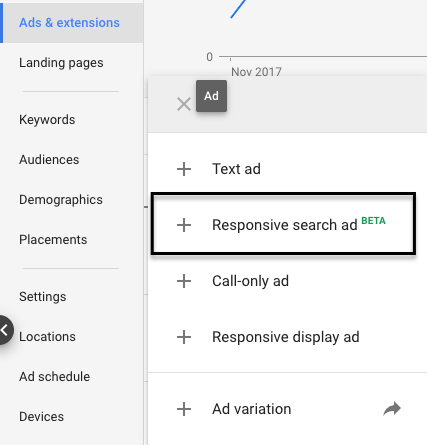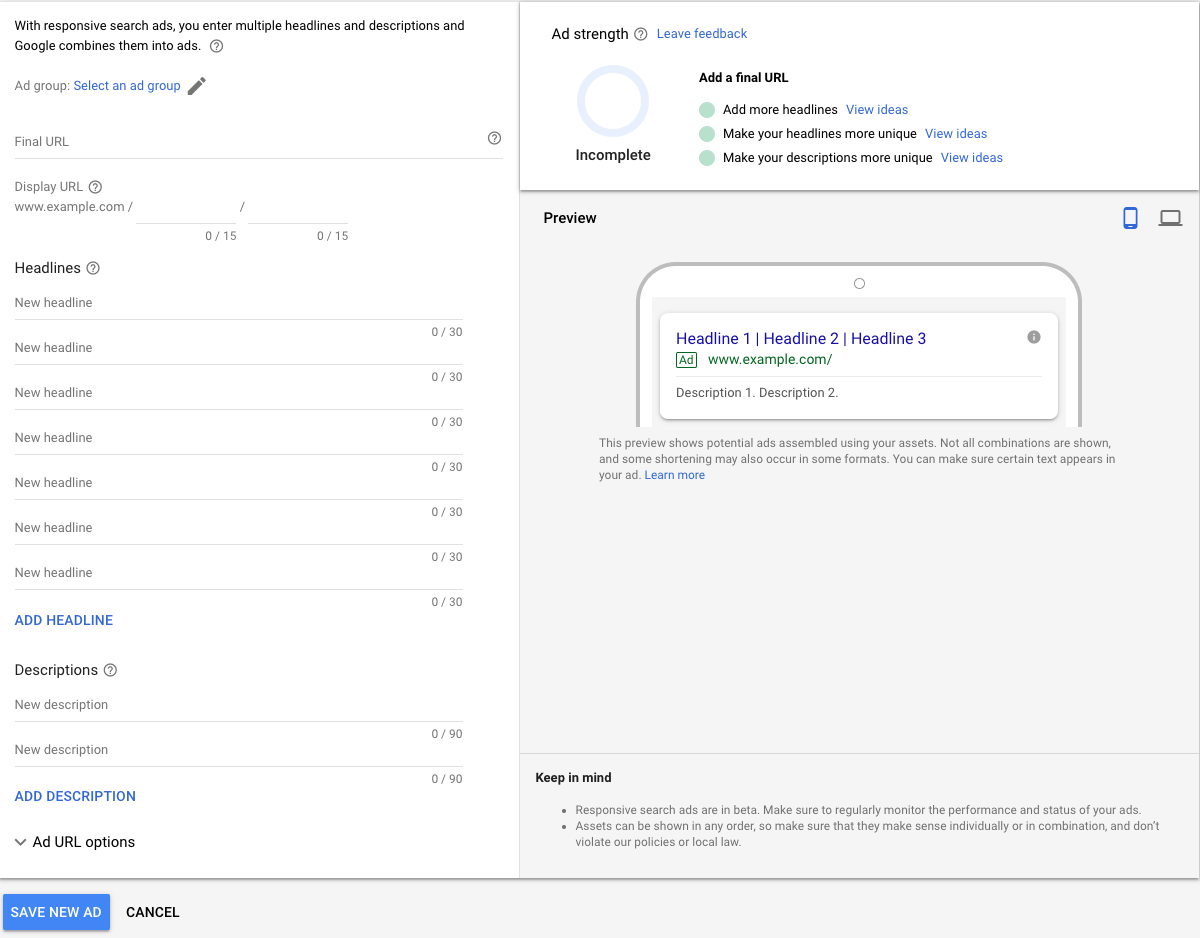Have you ever launched an ad and thought “Oh…wait..this is not performing the way I thought it would.” If you haven’t been there yet, you will be at some point. Sure, you can always pull an ad and make adjustments but will you have the time to do it in a timeframe that makes sense? Maybe not. A lot goes into adjustments: writing and changing copy, analyzing segment performance, and trying to figure out just where everything went wrong. What’s the solution?
Enter Google’s Responsive Search Ads. The ad format isn’t quite perfect yet and the performance reportedly lags behind existing search ad formats (though it’s not all terrible) but it is an exciting look into the future of paid search and the idea of people above keywords.
What are Responsive Search Ads?

Responsive Search Ads were introduced late last year by Google and they’re presently in Beta testing which may be why you may or may not have seen them yet. Google created this new type of search ad format to improve upon the current model and provide an incredible amount of flexibility and an increased chance of success as a result.
With a traditional ad you write a single headline and a single description before publishing it, but with Responsive Search Ads, you can write up to 15 different headlines along with 4 different descriptions for the same ad. Variety is the spice of life and Google is making sure your have more ways to engage your target audiences.
Here’s how it works: Google will automatically test different combinations of the headlines and descriptions you’ve created to determine which combination will perform the best. A Responsive Search ad can make use of three headlines and two descriptions at any given time. Recently, Google added the ability to have 3 headlines in a traditional search ad, something that helps increase your ad quality score but the Responsive Search ad takes that option up a notch.

As your ad runs, Google will automatically track how different combinations are performing in order to make changes based on a variety of user signals. Google will end up displaying the combination that it thinks will work best for different users based on the keywords they use, their search history, and their online behavior.
When taking into account the 15 headlines and 4 descriptions that you can write for each ad, Google can arrange your ad in 43,680 different permutations, resulting in nearly endless ad testing opportunities.
The Benefits of Using Responsive Search Ads
While we mentioned at the top of this post that the Responsive Search ad isn’t quite where it needs to be, it still offers a variety of exciting benefits to those who take advantage of it:
- Improve performance – By reaching a bigger audience and by automatically adjusting your ad’s titles and copy based on user signals, you’ll increase the clicks and conversions. Google is reporting that Responsive Search Ads have a 5-15% higher CTR compared to traditional search ads.
- Reach a bigger audience – Different users are going to react differently to titles and descriptions. Instead of only choosing one title and description that may not be appealing to a certain section of your audience, you can choose a variety, thereby reaching more potential customers. Not to mention that it will make your ads more competitive in different search queries.
- Responsive design – The responsive text format of the ads will automatically display in their proper size no matter what device is being used to view the ad, be it a desktop computer or a smartphone. This ensures your ad will have an impact despite the size of the screen it’s being viewed on. It will display a longer subject and description if there’s more room to view it on screen.
- Save time – While it may take a little longer to create a Responsive Search ad if you decide to write all 15 descriptions and 4 titles, doing so can save you a significant amount of time in the long run. This is because you won’t have to create new ads if your current ads are failing, nor will you have to spend time tracking analytics and making adjustments to your ads, all of which take up time and resources to do.
Tips For Getting the Most Out of Your Responsive Search Ads
The potential benefits certainly make Responsive Search Ads worth using. However, you need to make sure that you use them correctly in order to reap the rewards of this new format. The following are a few tips for creating effective Responsive Search Ads:
- Fill in all titles and descriptions – You don’t have to submit 15 titles or 4 descriptions, but you should (according not just to us, but to Google, as well). Technically, you could just do one of each–but then you’re essentially creating a traditional search ad, and aren’t you looking to up your game here? Take the time to submit the maximum number of titles and descriptions to improve your ad’s chances of being successful.
- Add variety to your ads – Since you have so many options, be sure to highlight different offers, calls-to-action, and value propositions in each element of your ad. The point here is to test multiple things and see what works. The more you have to test, the more optimizations that can occur.
- Use different lengths – Vary the length of your titles and descriptions so Google has more options when adjusting your ads. Google wants variety and will grant your ad higher quality scores if the algorithm can tell that you’ve done what Google has asked you to do.
- Strategically use keywords – Make sure a couple of your headlines have top keywords, but also try a few headlines with none of your keywords. This will prevent your titles from being too repetitive. Google will dock you points if it detects repetative or redundant text.
Although currently still in beta testing, Responsive Search ads are the future of online advertising. Whether or not you were previously using PPC ads, you should begin looking into the use of Responsive Search ads as a way to improve the performance of your ads.
Why should you care?
The landscape of advertising is not what it was even 5 years ago. Generation Z now makes up a growing share of the American population and their spending power is massive. But, they hate advertising. They’re digital natives and have spent their childhood online. They know an ad when they see one. They’re quick to abandon a brand for something that suits them better. They’re spending time with brands like Twitch, Reddit, Imjur, and TikTok. Notice a common thread? Image and video.
Millennials are a generation who grew up through the major technological boom. They’ve seen the creation and explosion of social media and digital marketing. They’re spending nearly 25 hours a week online (and that was back in 2016). Almost 36% of their total purchases are done on their mobile phones. Their spending time on social media, shopping sites, and youtube.
Gen X is the most brand loyal of the current generations. They’re spending more time online and they’re progressively more digital. They spend their time on the news, weather, banking, or government sites (and luxury travel).
Responsive Search affords brands the opportunity to deliver relevant and meaningful content to prospective customers in a way that actually appeals to them. Regardless of the multiple ways you can segment your audience– platform, age, location, or interest– you can design a wide variety of taglines and let Google mix and match them according to the profile they have for their users.
It’s not all rainbows with Responsive Search
Earlier we talked about the potential drawbacks of the existing state of Responsive Search advertising. Clix Marketing and Adalysis do a deep dive into the difference between the existing Search and Expanded Search Ads and Responsive Search Ads.
We’re hoping by the time the Responsive Search ends beta testing that it has the ability to outperform other traditional forms of advertising. Keep an eye out and we will keep you informed.
The TL;DR on Responsive Search
Google’s Responsive search is a new form of text-based advertising that takes Extended Search to a whole new level. You have the ability to write up multiple headlines and descriptions and give Google the ability to mix-and-match and test them to see which performs the best. The technology is still in beta and needs some more work before we’d recommend switching over to it. But, it is definitely something to keep an eye on for the future.
-FINAL(01-00)-White&Blue-01.svg)





